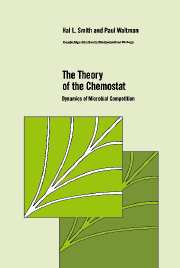
-
Select format
-
- Publisher:
- Cambridge University Press
- Publication date:
- December 2009
- January 1995
- ISBN:
- 9780511530043
- 9780521470278
- 9780521067348
- Dimensions:
- (228 x 152 mm)
- Weight & Pages:
- 0.616kg, 332 Pages
- Dimensions:
- (228 x 152 mm)
- Weight & Pages:
- 0.5kg, 332 Pages
You may already have access via personal or institutional login
Book description
The chemostat is a basic piece of laboratory apparatus, yet it has occupied an increasingly central role in ecological studies. The ecological environment created by a chemostat is one of the few completely controlled experimental systems for testing microbial growth and competition. As a tool in biotechnology, the chemostat plays an important role in bioprocessing. This book presents the theory of the chemostat as a model for larger ecological problems such as food chains, competition along a gradient, competition in the presence of an inhibitor, and the effects of time varying inputs. Models which take account of size structure, variable yields, and diffusion are also considered. The basic phenomena are modelled and analysed using the dynamical systems approach. Directions for research and open problems are discussed. Six appendices provide an elementary description of the necessary mathematical tools. Teachers, researchers, and students in applied mathematics, chemical engineering and ecology will find this book a welcome resource.
Reviews
"...a logically ordered and mathematically rigorous explication of the chemostat theory in terms of ODEs...the book can be recommended as a valuable source of reference for students, teachers, and researchers..." D.O. Logofet, Mathematical Reviews
"If you work with microbial systems and contend with dynamic and competition phenomena, this book will serve as a good, concise reference for problemas and approaches that are applicable to many fundamental and applied areas...Getting a copy for yourself or in the library would be worthwhile." Michael Domach, Journal of the American Chemical Society
"I...enthusiastically recommend this monograph to both scientists and mathematicians planning to do research related to chemostat-like models, for whom I think it will be indispensable." Gail S.K. Wolkowicz, Bulletin of Mathematical Biology
"The Theory of Chemostat by Smith and Waltman, two of the leading authorities on the thoery of the chemostat, provides an outstanding introduction to this thoery. Starting from the simplest models of the well-stirred chemostat, they lead the reader from the basic theory, through many of its elaborations, up to the frontiers of current research and many open questions and unsolved problems....This well-written, well-organized book is destined to become a classic in mathematical biology." J.M. Cushing, SIAM Review
Contents
Metrics
Full text views
Full text views help Loading metrics...
Loading metrics...
* Views captured on Cambridge Core between #date#. This data will be updated every 24 hours.
Usage data cannot currently be displayed.
Accessibility standard: Unknown
Why this information is here
This section outlines the accessibility features of this content - including support for screen readers, full keyboard navigation and high-contrast display options. This may not be relevant for you.
Accessibility Information
Accessibility compliance for the PDF of this book is currently unknown and may be updated in the future.


